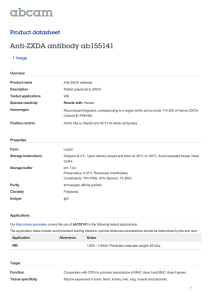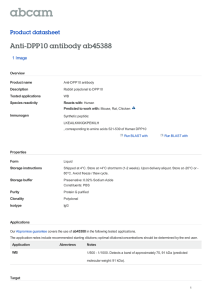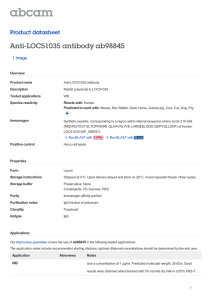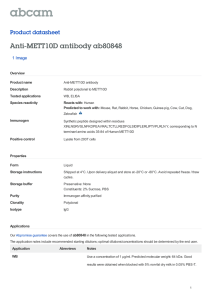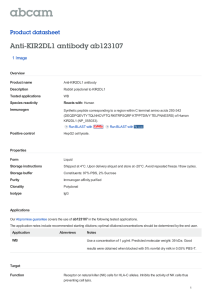Anti-HARS antibody ab65014 Product datasheet 1 Abreviews 2 Images
advertisement
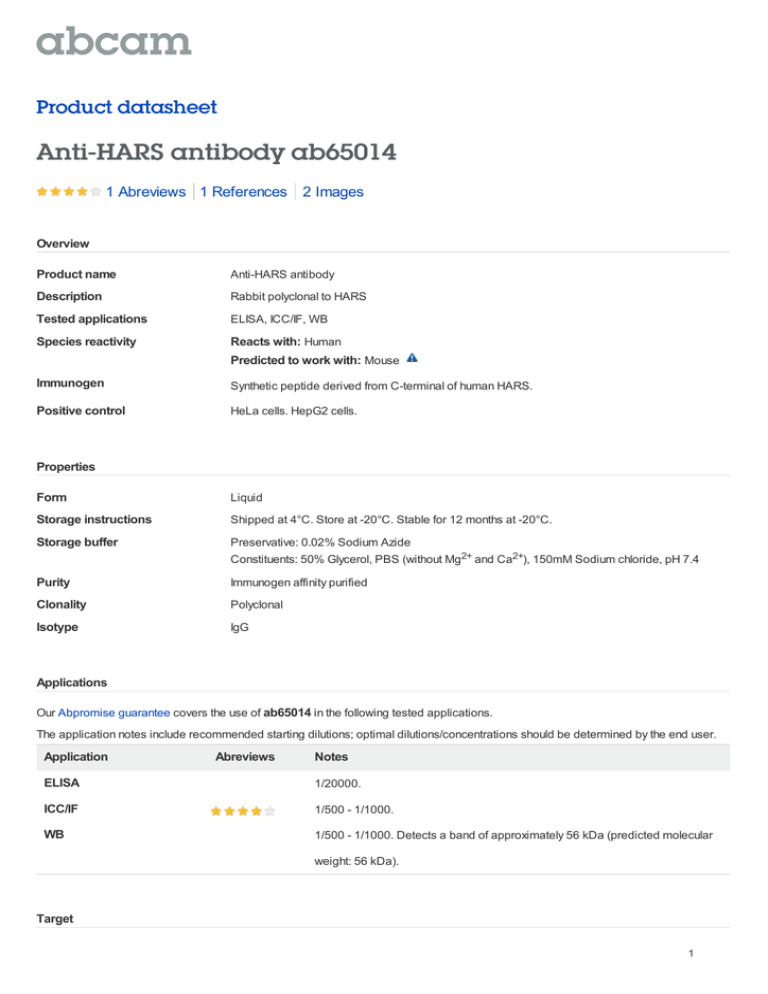
Product datasheet Anti-HARS antibody ab65014 1 Abreviews 1 References 2 Images Overview Product name Anti-HARS antibody Description Rabbit polyclonal to HARS Tested applications ELISA, ICC/IF, WB Species reactivity Reacts with: Human Predicted to work with: Mouse Immunogen Synthetic peptide derived from C-terminal of human HARS. Positive control HeLa cells. HepG2 cells. Properties Form Liquid Storage instructions Shipped at 4°C. Store at -20°C. Stable for 12 months at -20°C. Storage buffer Preservative: 0.02% Sodium Azide Constituents: 50% Glycerol, PBS (without Mg2+ and Ca2+), 150mM Sodium chloride, pH 7.4 Purity Immunogen affinity purified Clonality Polyclonal Isotype IgG Applications Our Abpromise guarantee covers the use of ab65014 in the following tested applications. The application notes include recommended starting dilutions; optimal dilutions/concentrations should be determined by the end user. Application Abreviews Notes ELISA 1/20000. ICC/IF 1/500 - 1/1000. WB 1/500 - 1/1000. Detects a band of approximately 56 kDa (predicted molecular weight: 56 kDa). Target 1 Tissue specificity Brain, heart, liver and kidney. Involvement in disease Defects in HARS are a cause of Usher syndrome type 3B (USH3B) [MIM:614504]. USH3B is a syndrome characterized by progressive vision and hearing loss during early childhood. Some patients have the so-called 'Charles Bonnet syndrome,' involving decreased visual acuity and vivid visual hallucinations. USH is a genetically heterogeneous condition characterized by the association of retinitis pigmentosa with sensorineural deafness. Age at onset and differences in auditory and vestibular function distinguish Usher syndrome type 1 (USH1), Usher syndrome type 2 (USH2) and Usher syndrome type 3 (USH3). USH3 is characterized by postlingual, progressive hearing loss, variable vestibular dysfunction, and onset of retinitis pigmentosa symptoms, including nyctalopia, constriction of the visual fields, and loss of central visual acuity, usually by the second decade of life. Sequence similarities Belongs to the class-II aminoacyl-tRNA synthetase family. Contains 1 WHEP-TRS domain. Cellular localization Cytoplasm. Anti-HARS antibody images ab65014 at 1/500 - 1/1000 dilution staining HARS in HepG2 cells by Immunofluorescence, in the absence or presence of the immunising peptide. Immunocytochemistry/ Immunofluorescence HARS antibody (ab65014) All lanes : Anti-HARS antibody (ab65014) at 1/500 dilution Lane 1 : HeLa cell extract Lane 2 : HeLa cell extract with immunizing peptide at 10 µg Lysates/proteins at 30 µg per lane. Western blot - HARS antibody (ab65014) Predicted band size : 56 kDa Observed band size : 56 kDa Additional bands at : 20 kDa,37 kDa,40 kDa. We are unsure as to the identity of these extra bands. Please note: All products are "FOR RESEARCH USE ONLY AND ARE NOT INTENDED FOR DIAGNOSTIC OR THERAPEUTIC USE" Our Abpromise to you: Quality guaranteed and expert technical support 2 Replacement or refund for products not performing as stated on the datasheet Valid for 12 months from date of delivery Response to your inquiry within 24 hours We provide support in Chinese, English, French, German, Japanese and Spanish Extensive multi-media technical resources to help you We investigate all quality concerns to ensure our products perform to the highest standards If the product does not perform as described on this datasheet, we will offer a refund or replacement. For full details of the Abpromise, please visit http://www.abcam.com/abpromise or contact our technical team. Terms and conditions Guarantee only valid for products bought direct from Abcam or one of our authorized distributors 3
